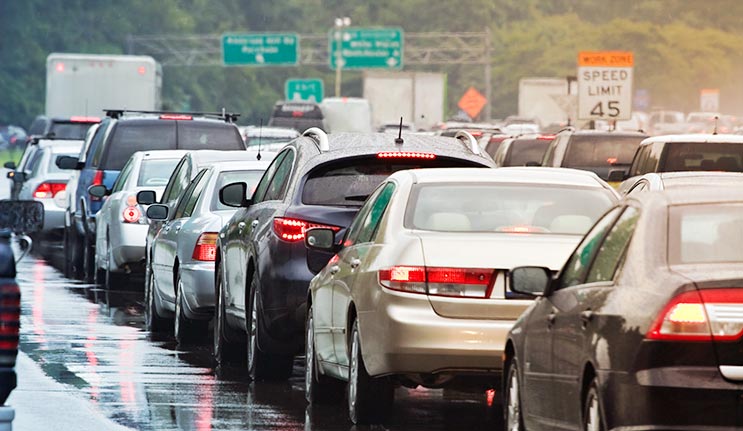All across America, people rely on the freeways and roadways where the live. They use them to commute to work, pick up or drop off their kids at school, go to the movies, grocery shop…you name it. In more heavily populated areas, with everyone zipping this way and that, it can lead to a lot of vehicles on the road. With these great numbers comes a higher likelihood for vehicle accidents and collisions. So what can you do?
The current collision statistics are shocking. The National Safety Council reported that in 2016 there was a reported 40,200 motor vehicle deaths in the U.S. This was a 6% increase from the year before. California alone was responsible for 3,680 of them. According to an accident study conducted by Thrillist in 2015, the odds of getting into a fatal car accident in the state of California is 1 in 6,036.
With high numbers like this, what can we do on the roads to protect our safety? As the statistics indicate, accidents are bound to happen whether you like it or not, and people are going to make mistakes on the road. However, there is a way to be proactive on the road while driving that can drastically improve your chances for remaining safe. And this is through defensive driving techniques.
Some of these tips are more commonplace and shared every day, but there are some good tactics out there that people might not be aware of. I want to help increase your chances of staying safe, so I compiled a list of defensive driving techniques (including a bonus tip for holiday road travel) that can help you avoid those crashes. Here’s a breakdown of each of them:
#1. Keep Distance from Yourself and Motorists Ahead.
People used to say to keep at least a “car-length of distance” between other vehicles, but what does this really mean? It’s pretty vague and confusing, so nowadays, people and the authorities recommend adopting a 3- to 4-second rule to anticipate sudden braking or speed changes. So how do you go about calculating this? Try this tip from Kidshealth.org: pick a stationary object on the side of the road. When the vehicle in front of you passes the object, start counting one thousand one, one thousand two, and so on. If you pass the designated object before the count of one thousand three, you are too close!
#2. Minimize the Risks for Pesky Tailgaters.
It’s very irritating when people tailgate, or follow too close to your vehicle. Not only is it rude, but it’s also dangerous. If someone is tailgating very closely behind you, you should add 2 times as much space between your car and the car ahead. This helps you see and prepare for a collision. If you are able to, try to move into a right-hand lane, or pull over momentarily to let the tailgater pass. And avoid hitting the brakes suddenly, unless you are forced to do so.
#3. Monitor Your Own Blind Spots.
Even if you have the best mirrors or backup cameras on the market, and no matter what vehicle you are driving, there is always a blind spot around your vehicle. And blind spots are frequently the root cause of crashes. To help with this, it might be a good idea to adopt the habit of looking over your shoulder every time before you change lanes. This method is also very helpful in spotting motorcycle riders that are lane-splitting and weaving in and out of traffic.
#4. Try to Stay Out of Other Vehicle’s Blind Spots.
As we covered above, you have blind spots around your vehicle, and everyone else has them too. If you can avoid it, it’s a good practice to consciously stay out of the blind spot zones of the vehicles to the left and right of you. This is also very important for driving around trucks that have significantly larger blind spots around their sides and rear.
#5. Use Your Turn Signal and Make Lane Changes when Space is Available.
You should always use your turn signal to indicate your intent to turn or change lanes. But, don’t just activate your turn signal and expect people to allow you in. If the other driver is not paying attention or checking his radio, he might not see your lane change intent. Instead, it’s beneficial to wait for a reasonable gap to appear before you make your move. Or you can adjust your speed to find the prime opportunity to make your lane change.
#6. Avoid Distracted or Dangerous Drivers.
Distracted driving has become a huge road safety issue in our society. Mike Bomberger, a San Diego car accident attorney with Estey & Bomberger, LLP supports this with the following statement:
“The roadways are changing, and large commercial trucks, driverless cars, and an increasing number of driver distractions increase the types of accidents that may occur. Distracted driving alone contributes to around 1,161 injuries throughout the United States every day.”
We need to be sure to keep an eye out for swerving, or potentially intoxicated drivers.
So, if someone is clearly texting while driving, taking on their phone, or putting on makeup, it’s a good idea to keep your distance. And you should obviously report intoxicated drivers to the police, if you encounter them.
#7. Assume the Worst from Drivers.
I know this sounds like a bummer, but it’s better to be safe than sorry. It’s a good idea to watch other drivers and assume that every driver is going to speed through a yellow light or ignore a stop sign. And it’s a good idea to keep a closer watch on the age of the drivers around you, especially teenagers or the elderly. The U.S. Census Bureau calculated that approximately 12.2% of accidents are the fault of teenage drivers while 7.5% of accidents are caused by drivers aged 65+.
#8. Follow the Posted Signs and Laws.
There is an assumption that as long as you are following the flow of traffic and doing whatever the other drivers are doing ahead of you or in neighboring lanes, then it’s okay for you to follow suit. This is definitely not the case. You should always remember to watch your speed, slow for posted turns and light signals, and be on the lookout for construction or road worker warnings, or any other hazards that might be on the road to your destination.
#9. Look Ahead!
It’s good to be able to anticipate any dangers or fluctuations in traffic. If you can see the road far ahead of you, you can scan for potential traffic halts, road conditions, or other road hazards like pedestrians or bicycles. This way, you give yourself ample time to slow down or move to avoid the potential threat. Obviously, this is not possible with every road or freeway, knowing they are full of turns and obstructions, but when you can, try to scan the horizon.
#10. Minimize your own Distractions
Whatever you can do to avoid the temptations of distractions, do it! If you receive a phone call, simply ignore it until you can safely pull over. Even hands-free systems have been shown to cause what’s called “cognitive distraction.” If you need to urgently text someone, pull over or wait. It’s not worth endangering your life or others’. Resist the urge to change radio stations or Spotify channels until you are at a stoplight or when you get to your destination. Or just stick to the same channel or album for the duration of your trip. It’s important to stay focused the entire time you are on the road.
#11. Getting the Bigger Picture…
So, you can’t control what anyone else is going to be doing on the road. But you can control what YOU are doing. Collisions are statistically inevitable, but if you can take extra precautions to minimize the risks that come with sharing the road, you’ll significantly improve your odds of helping everyone reach their destinations safely. So start driving defensively out there!
#12 (BONUS TIP). Be Extra Patient During the Holidays
The holidays can be a stressful time for many due to increased professional and social obligations. This increased demand on people can lead to poor decision making on the road. Add to this the reality that drunk driving accidents increase during the holidays and the fact that texting and driving isn’t abating, and you now have a recipe for some serious danger. Adhere to these holiday driving tips from Bankrate.com to give yourself the best chance for an enjoyable and safe time with family, friends and coworkers:
- Remain Alert
- Leave Early
- Drive Defensively
- Drive Sober
- Plan for the Weather
- Watch for Black Ice
- Don’t Text and Drive
- Service Your Car
About the Author
 Darryl Blank is a writer hailing from San Diego, CA and writes about safety, family, legal and self-help topics. He often works and writes in collaboration with the law firm Estey & Bomberger, LLP, which is a San Diego personal injury lawyer team.
Darryl Blank is a writer hailing from San Diego, CA and writes about safety, family, legal and self-help topics. He often works and writes in collaboration with the law firm Estey & Bomberger, LLP, which is a San Diego personal injury lawyer team.
Protect your employees with these training courses on defensive driving:
Defensive Driving – Small Vehicles






